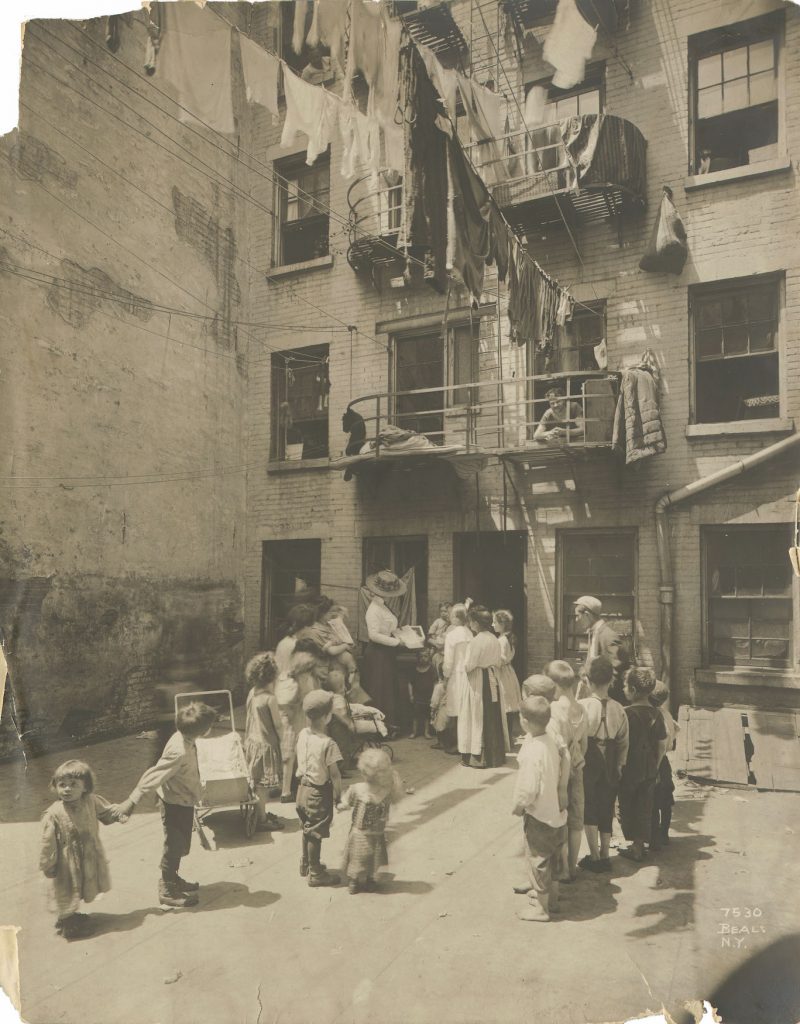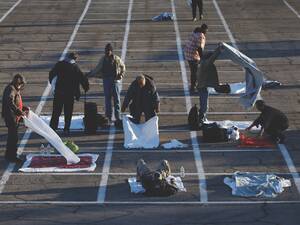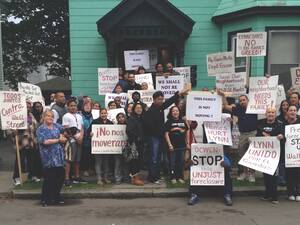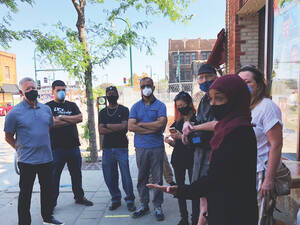On Preventing Pandemic Displacement
We must improve the housing that helps illness spread—without displacing the people who live there.
Click here to read the rest of the conversation.

THERE IS NO SEPARATING the pandemic from housing. A map produced by the Association for Neighborhood & Housing Development near the peak of New York City’s initial spike showed a correlation between Covid cases and the neighborhoods with the highest concentrations of overcrowded housing—heavily populated by service workers and people of color. As internist Margot Kushel told The New York Times in August, “Covid has really become a story of essential workers living in crowded housing.”
We’ve been here before. An epidemic hits, and as it ripples through our cities, it alters how we see our surroundings, prompting us to ask: How must we reshape our built environments to prevent another outbreak? Historically, in the United States, the way planners, politicians, and developers have answered this question has followed an insidious pattern, in which those who live in housing that’s vulnerable to the spread of an illness are themselves pathologized, and then displaced. The flawed housing is demolished and rebuilt to be more hygienic, but priced to exclude its former residents, who must again find shelter in dangerous housing.
In the late 19th and early 20th century, the so-called “Lung Block,” bounded by Cherry, Monroe, Market, and Catherine Streets in New York’s heavily poor and immigrant Lower East Side, captured elite imaginations as an emblem of overcrowded living conditions, high rates of disease, and—in patrician observers’ eyes—morbidly ill-mannered residents. The block took on its grim nickname in 1903, when the muckraking journalist Ernest Poole’s dramatic reporting made its high rates of tuberculosis a cause célèbre. It’s no mystery why TB spread so effectively there, with about 4,000 people who could afford no other place to live crammed into a tight ring of tenement buildings, each subdivided into tiny, under-ventilated quarters.
After decades of controversy, the New Deal state offered a private developer $8 million (roughly $158 million today) to tear down the tenements and reconstruct the block as Knickerbocker Village—the first federally-subsidized private housing project in the US. Opened in 1934, the new development housed roughly the same number of people, but in a dozen taller buildings, organized into two rectangular blocks and designed with larger rooms, interior courtyards, and greater light and air flow. Knickerbocker Village was not built for the urban gentry—Julius and Ethel Rosenberg were among the early residents, and the complex was long home to a radical tenants union—but its apartments were priced to exclude those who had suffered through the mortally crowded conditions that prompted the block’s redevelopment in the first place. According to a survey of former Lung Block residents, 80% of those displaced simply moved to other tightly-packed tenements. Whatever its merits, Knickerbocker Village ultimately did nothing to fix the problem the pandemic laid bare: that poor people are forced to live in dangerous conditions. It just moved the problem elsewhere.
This wasn’t the first time the pattern played out, and it wouldn’t be the last: Previous rounds of tenement reforms in New York City had produced similar results, as have recent attempts to construct sustainable housing after hurricanes in waterfront cities like New Orleans. Again and again in US planning history, after disaster strikes, public–private partnerships aimed at addressing the deadly living conditions faced by the city’s poorest residents—particularly when such conditions exist in coveted downtown locations—have been designed to displace rather than rehouse. Whether through building codes that mandated minimum safety standards for construction and habitation, zoning laws that sought to maximize light and air, or urban renewal programs that practiced “slum clearance” to replace old buildings with modern housing blocks, planners and real estate developers have responded to epidemics—as well as fires, floods, and other deadly events—by pathologizing and removing not only the structures that caused harm, but the communities who dwelled in them.
Of course, new construction—especially when it includes roomier apartments and wider open spaces—tends to be more expensive than older, more tightly-packed housing. Given these cost realities, the state’s repeated refusal to provide sufficient subsidies or price controls for the new buildings amounts to an abdication of the responsibility to safely house the displaced. This deficiency has often been justified through a racist rhetorical trick: slipping into pathological metaphors that shift from the architectural conditions to the people most commonly infected. A representative line from the most famous of tenement reform advocates, Jacob Riis, demonstrates the pattern: “Penury and poverty are wedded everywhere to dirt and disease, and Jewtown is no exception. It could not well be otherwise in such crowds, considering especially their low intellectual status.” Is the problem the crowding? The ignorance? Or is it the Jews? First there is a plague; then the buildings are a blight on the city; finally, their residents are a pox on the nation.
These familiar dynamics are beginning to play out again, as Covid-19 sweeps through the world, hitting cities particularly hard. Within the US, poor people, immigrants, and Black people are seeing disproportionately high rates of both infection and mortality, leading commentators to speculate blithely about the dangers of cities as such (rather than the dangers of overcrowded housing), or to flirt with eugenics, pondering whether some racial groups might simply be greater vectors for disease.
The reason for the disparity isn’t hard to understand: We live in a country in which Black people and immigrants disproportionately work dangerous and low-paying jobs in close proximity to others, and live in perilously overcrowded and polluted conditions. Safer, cleaner, and more spacious housing options are priced prohibitively high and are often systematically denied to people of color by a racist real estate industry and planning culture.
Given the historical precedents, it likely won’t be long before we start hearing renewed calls to raze the overcrowded and poorly constructed buildings that have fostered high coronavirus infection rates. This is not a bad thing in and of itself; these buildings should be replaced with safer, more generously apportioned ones. But when it comes time to reimagine our building codes, zoning maps, and safety regulations, we must reject the historical pattern of displacement-driven building improvements, which condemns the tenants along with the housing.
Designing a safer city, then, must include not only rethinking architectural standards, but also designing systems to diligently count, care for, and rehouse those currently subject to overcrowded and under-ventilated conditions. Every person who lives in unsafe conditions must be contacted and offered sanctuary, regardless of citizenship status or ability to pay. They must be provided with temporary housing while their former homes undergo reconstruction; prioritized for occupancy of the new, safer housing; and guaranteed permanent affordability. Rent controls must prevent rents from inflating beyond incomes, subsidies must cover the gap between building revenues and maintenance costs, and sales caps must ward off real estate speculation.
US housing policies have often promised these kinds of protections, but they’ve rarely delivered them. Planning in the capitalist city has instead prioritized profit for landlords, lenders, and investors over residents’ right to enjoy the improvements in good health. Post-pandemic progress must be measured not only by whether building conditions are improved, but also by whether those who suffered through substandard conditions are the ones who reap the benefits.
Samuel Stein is the author of Capital City: Gentrification and the Real Estate State.




